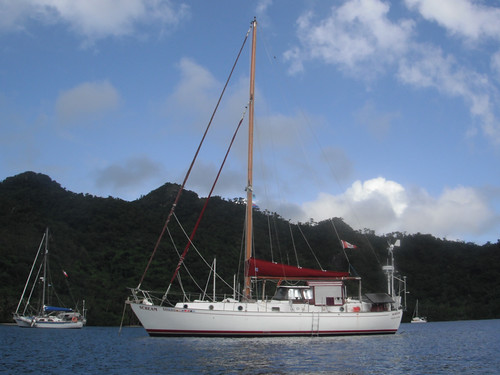Catching rain
We've been catching rain to fill our water tanks on Scream for two years now. We've actually caught rain about a dozen times, and we've tried about another dozen times when it didn't rain enough. Rain water accounts for about half of our annual water, and most of our water while cruising. We take on dock water a couple times a year and get a fraction from our desalinator.
Our rain catching technique is primitive. We only try to catch rain when it rains so heavily that visibility is reduced. First we wait for the rain to wash the deck clean. As the deck is generally pretty clean, heavy rain makes it spotless in a minute or two. Then we simply create a dam on the side deck along the toerail with a rolled up towel then open the deck fill. We add half of a tea ball to strain out any gunk, and watch the puddle drain into our tanks.
Rain catching can be more sophisticated. Our friends on Nomzamo had their cockpit awning made so that it pools water and it has hoses that collect the water. Our friends on Freedom have scuppers that drain into hoses before going overboard. They added a Y-valve and catch water with just the flip of a switch.
We have several dream upgrades to our water catching. First, we'd build a water filter into the pipes between the deck fill and the tank. Next we'd make pooling the water easier, possibly by making water tight plugs for all of our scuppers. Finally, we'd add a ridge and a pair of scuppers to the foredeck so that mud from the anchor chain doesn't get on deck.
While heavy rain is not frequent, several times a year we have rain falling heavily enough that we collect hundreds of liters in less than an hour. Even during the dry season, most places in the tropics get 100mm of rain a month. Each milimeter of rain is a liter of water for every square meter. Most cruising boats are around 12m long and 4m at the beam. Boats aren't square, but the deck area ends up around 30 m^2. But you won't be able to collect water from every rainfall nor all of the water than lands on deck. Something like one quarter of your deck area of 30m^2 and maybe half of the rain seems about right from our experience. That still works out to around 3 liters for every millimetre of rain, and most places in the tropics get over 100mm of rain per month in the dry season.
My closing thought is about desalinators. Our desalinator is the most expensive item we have added to Scream. It is also the least reliable. Our rain catching is primitive and has no special equipment, therefore no cost and no repairs. And while the desalinator was how we survived the deserts of Mexico, since then catching rain has taken care of a lot of our needs.


